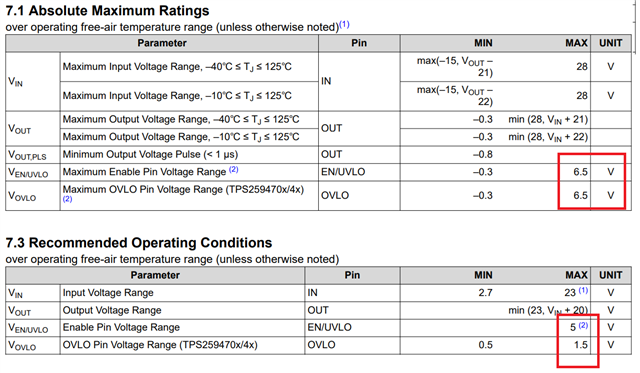Other Parts Discussed in Thread: TPS25946, TPS25948
Tool/software:
Hello all,
In my design, I intend to interface the TUSB319 CC controller with the TPS25947.
The TUSB319 has an ID pin, which is an open-drain output that acts like an EN_N pin (asserted low when the CC pins detect device attachment).
I’m considering using the TPS25947's OVP pin for this purpose, as described in the datasheet:
Section 9.6 – USB PD Port Protection (page 53):
“The PD controller can also use the OVLO pin as an active-low enable signal to control the power path. Holding the OVLO pin high keeps the device in the OFF state in sink mode and blocks current in both directions.”
Ideally, I would use a pull-up resistor connected to VBUS to pull OVP up to 5V, and then connect the OVP pin directly to the CC controller's ID pin.
However, when looking at the absolute maximum and recommended operating conditions for the OVP pin, I noticed something strange:

The EN/UVLO and OVP pins both have a 6.5V absolute maximum rating, which makes sense. However, the recommended operating maximum for the OVP pin is only 1.5V, while for EN/UVLO it’s a much higher 5V.
Does it make sense that the OVP recommended maximum is only 1.5V?
I also checked the EVM schematic and observed the following:

If VIN max is 23V, then the OVP pin will see:
23V × 158kΩ / (158kΩ + 2MΩ) = ~1.68V,
which is higher than the stated recommended maximum operating voltage.
Is the 1.5V figure correct?
Thanks,
Nir



